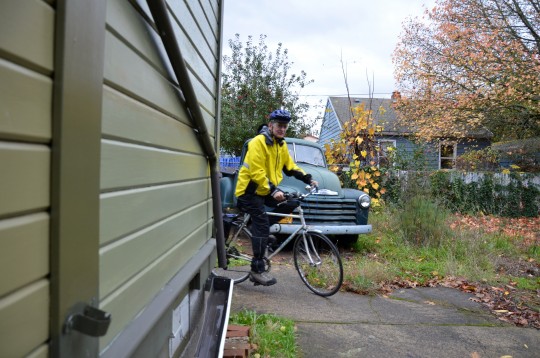
(Photos: M.Andersen/BikePortland)
It’s 8:10 a.m. on Friday morning and the most controversial man in the Richmond neighborhood has just finished reading the funnies.
The doors of the shops he passes open directly onto the sidewalk. They have to; that’s what it says in the code that Klotz helped the city write.
“They still print it every day, they just refuse to deliver it,” Doug Klotz says.
He says it in the same way he says a lot of things: amused, annoyed and apropos of nothing.
Then he folds shut The Oregonian’s living section, eats the last bite of his sausage and brushes aside his flop of gray hair.
In five minutes Klotz, 64, will be rolling his bike down the driveway of the creaky 1905 house that he and his wife, Marsha Hanchrow, live in and have been very gradually renovating since 1999. He’ll pass his green 1952 Chevy, its battery hooked to a trickle charger to stop it from going dead between uses. Then he’ll head to work.
On the way, he’ll pass the three-story building at Hawthorne and 34th that would almost certainly be a McDonald’s drive-through today if the plan to build it hadn’t run into trouble with the Richmond Neighborhood Association, whose land use committee Klotz was chairing back in 2001.
Today, the row of mixed-use storefronts and condos the developer finally agreed to build instead is full of boutique clothing shops, the western anchor of a commercial district that runs east to 50th Avenue.
Like almost every Portland storefront built facing a transit line since 1991, the doors of the clothing shops open directly onto the sidewalk, not a parking garage or surface lot. They have to; that’s what it says in the code that Klotz helped the city write, a project that at one point featured a sketch by Klotz on its cover.
Klotz’s commute takes him west down Madison. It’s been his route to work since 2003, when he switched from bus to bike to save money.
Madison’s sidewalks, built around 1905 with grassy buffers between them and the curb, look a lot like sidewalks in new subdivisions across the country. That’s because the 1998 Portland Pedestrian Design Guide that Klotz helped create, which ended up being a model for many U.S. cities, specified that instead of running right along the curb, every new sidewalk should have a buffer of at least two feet.
“Like the ones in the older neighborhoods,” Klotz says.
Klotz crosses Grand Avenue and passes into the Central Eastside Industrial District.
“I’ll need to change clothes,” he mentions. “Into my uniform.”
Then Klotz pulls up to Wink’s Hardware, rolls his bike inside, and starts his work day.
Change agent with a day job
How did Doug Klotz get into this pickle?
How did a hardware store clerk with a film degree become the subject of duelling mass email campaigns that rallied 252 people to a Sept. 14 vote over whether to recall him from the board of the neighborhood association where he’s served since 1993 — and how did Klotz, despite more than 150 people who showed up entirely to vote him out, remain in office by a single vote?
Officially, the issue is that Klotz violated the Richmond Neighborhood Association’s code of ethics when he described several board members in an email to biking advocates as “less than bike friendly.”
It’s very likely true that this was a violation of the RNA’s rules, which forbid RNA board members from making “public statements representing the views of the organization” without permission from the board. That was the conclusion last month of a special investigative committee.
But the truth is that hundreds of people did not pack a meeting to vote for or against Klotz because he was trash-talking other neighborhood board members.
They showed up because Klotz is so good at advocating for his beliefs that his decades of volunteer work have, gradually, added up to actual changes.
Big changes.
‘Things were not getting built’
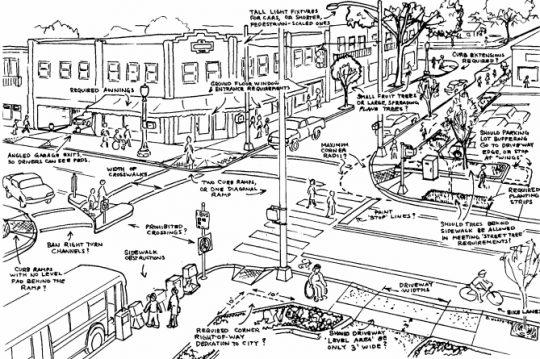
When Michele Wong was growing up off Division Street, friends who lived west of the Willamette River told her they were scared to visit the east side.
“It wasn’t that nice of a neighborhood,” said Wong, whose parents had bought land along Division in the 1960s.
People called her father a “slumlord,” she said in an interview Thursday. When she started getting into retail development, some people thought she was “a front for him.”
That was what happened when Wong first showed up at the Richmond Neighborhood Association in the late 1990s, asking for permission to redevelop a corner lot at Division and 30th to a ground-floor cafe with two apartments above.
“Things were not getting built and the impediment seemed to be the parking requirements.”
— Doug Klotz
The city approved her plan on the condition that she rent two off-street parking spaces from someone else nearby. But nobody would lease them to her.
“They thought I was putting in a strip bar for some reason,” Wong said. “We kind of abandoned the project. … And ended up doing a vacant lot for a long time.”
Vacant lots weren’t what Klotz and other members of the Richmond Neighborhood Association were hoping for, either. They were eager for nice places to eat and socialize nearby.
“Things were not getting built and the impediment seemed to be the parking requirements,” Klotz said.
So the RNA supported a city request to get rid of minimum parking requirements within 500 feet of a frequent bus line.
In 2005, Wong tried her plan again. This time, it went through.
“They changed the whole parking issue, so we didn’t need parking any more,” she said.
Caffe Pallino opened there in 2007, the first of a series of new retail shops on the block that now faces the Bollywood Theater restaurant and a painfully quirky mixed-use remodel called D Street Village. The shop recently changed hands and now houses American Local, one of Division Street’s latest award-winning restaurants.
A transforming city
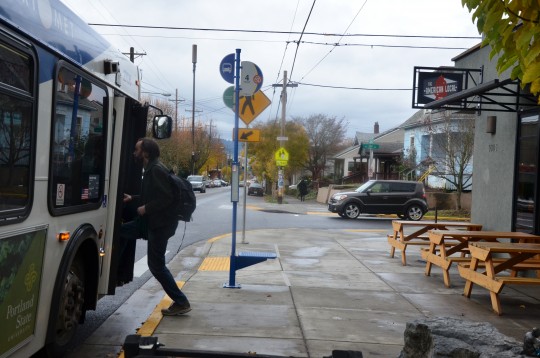
Like most people who’ve owned houses near Hawthorne and Division for more than a few years, Klotz and Hanchrow don’t make enough money to buy into their neighborhood today.
Is that because of the new buildings that Klotz helped make possible?
Klotz said Richmond was already getting expensive before people like Wong (who sold Caffe Pallino and now runs Old School Coffee on 82nd Avenue) started building shops and opening restaurants.
“The price has gone way up because people want to live in the inner city,” Klotz says. “We’re not allowing the type of building that would solve that problem.”
If the city focused less on saving room for cars, Klotz argues, more projects could be built, and Portland’s housing supply could better keep pace with the 10,000 or so net new residents that have shown up almost every year since 1987 — which also happens to be the year Klotz arrived.
But Klotz wasn’t always a fan of density. He only started supporting bigger buildings on main streets because he gradually decided that they were the best way to support something else he believed in deeply: walking.
‘Unless you have the density, you’re not going to get a walkable neighborhood’
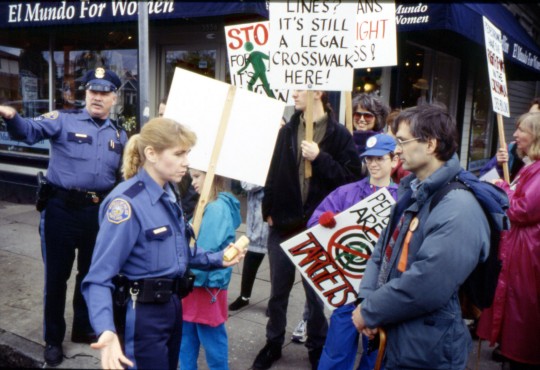
(Photo courtesy Ellen Vanderslice)
You’ve heard of the advocacy group Oregon Walks? It was Klotz’s idea. Seven Portlanders founded it in his living room in 1991.
Or maybe you’ve heard of the crosswalk enforcements the City of Portland conducts every few months. The city got the idea from Klotz and his Oregon Walks co-founder Ellen Vanderslice, who in the early 1990s started walking back and forth across crosswalks as do-it-yourself street demonstrations.
Over time, Klotz’s affection for walking and for riding good bus lines — like the 14, on which he and Hanchrow met — became an affection for neighborhoods that had enough density to bring storefronts and good bus lines within walking distance.
“I decided maybe 7 or 8 years ago that unless you have the density, you’re not going to get a walkable neighborhood,” Klotz said. “The customer base supports businesses to be there.”
Vanderslice, who like Klotz trained as an architect but who unlike Klotz finished her degree, was hired off the board of Oregon Walks to write Portland’s Pedestrian Design Guide, the one that became widely imitated. She retired in 2012 from a celebrated career at the city, during which she sometimes came to envy her friend’s job at the hardware store.
“It’s an interesting thing: in keeping his professional life really separate,” she said, “he can say whatever he wants and he can really speak the truth.”
“In comparison, look at me — I got tired and I quit!” she said. “I got burned out.”
‘He is sort of an odd duck’
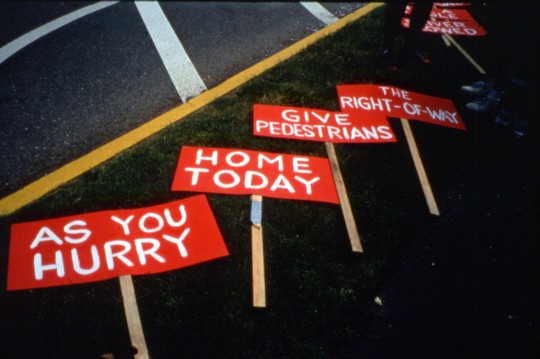
(Photo courtesy Ellen Vanderslice)
Klotz now calls himself “semi-retired.” He’s down to two days a week at Wink’s: Mondays and Fridays from 9 to 5:30.
His co-worker Kaiya Ketterman said Klotz often talks to other shop employees about issues around town. She said those conversations usually start with him muttering to himself about an email he’s just received.
“Everybody always says that he should be mayor,” she said.
“So many of our really dedicated, wonderful, brilliant citizen volunteers are annoying.”
— Ellen Vanderslice, co-founder, Oregon Walks
Klotz hoped that by downshifting at the hardware store, he’d be able to devote more time to finally fixing up his house.
“But all these other things expand to fill that space,” he said. “Forestry Commission, Planning Commission. … I can go to design review hearings! I can go to preapp conferences!”
Klotz doesn’t sit on those commissions. But he’s learned that if he attends, people who are on them will listen to him.
Lately he’s become passionate about getting trees to be planted closer to street corners, to reduce the size of heat islands at intersections.
Advertisement
“Some of the characteristics become sort of exaggerated with age, just like our ears get longer,” reflected Vanderslice. “So many of our really dedicated, wonderful, brilliant citizen volunteers are annoying.”
And Klotz can be, his fans and foes agree, pretty annoying.
“He’s brilliant,” said Vanderslice. “He’s absolutely brilliant. But — and he recognizes this — he does not have some of the skills that it takes to run an organization.”
“He is sort of an odd duck, but I think he means well,” said Wong, who said she “understands what Doug is trying to accomplish” but thinks his goals are unrealistic.
“The thing is, cars are kind of a fact of life,” she said. “It kind of stinks, but people need their cars.”
Ethics and action
Steve Gutmann, a Richmond resident who’s also vice president of the board for the anti-sprawl group 1000 Friends of Oregon, said the Richmond neighborhood Klotz has helped create is the one Gutmann and his wife had dreamed of when they moved to the area 14 years ago.
“We would ride our bikes up and down Hawthorne and Division just sort of imagining how great it would be if and when those commercial strips transformed from, frankly, pretty crappy strips into places where we would want to walk over to and spend our time,” Gutmann said. “And that’s happening.”
“We would ride our bikes up and down Hawthorne and Division just sort of imagining how great it would be if and when those commercial strips transformed.”
— Steve Gutmann, Richmond resident since 2001
Gutmann called Klotz a “neighborhood hero” for “taking a lot of the heat for policies that many of us here are benefiting from.”
Steph Routh, who served as director of Oregon Walks after Klotz had left its board, said one of the oddest things about Klotz is that she’d never seen him discouraged.
“It’s not in Doug to do nothing,” Routh said. “Ethics and action are one and the same. Doug treats goodness as a verb, not a noun or an attribute.”
Linda Nettekoven, another neighborhood advocate who has worked with (or against) Klotz on numerous issues since the Hawthorne Boulevard McDonald’s, called Klotz “a wonderful example of one of the people who make Portland a special place.”
“He has strong opinions, but he is willing to listen, and he is fun to argue with,” she said. “The notion that there are people in our community — and there are lots of them — who have stuck with issues across so many years and try to look at the bigger picture and see how the pieces fit together … I think that’s one of Portland’s great strengths.”
— Michael Andersen, (503) 333-7824 – michael@bikeportland.org
Corrections 11/15: Earlier versions of this post misspelled Caffe Pallino and slightly misquoted Vanderslice.


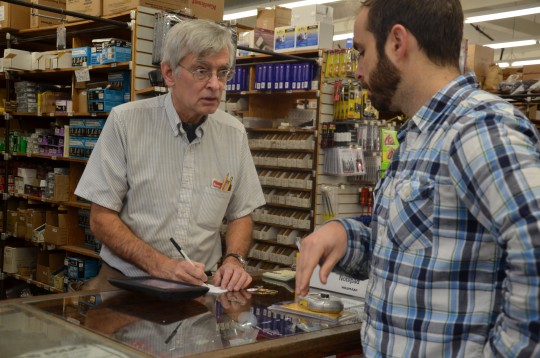
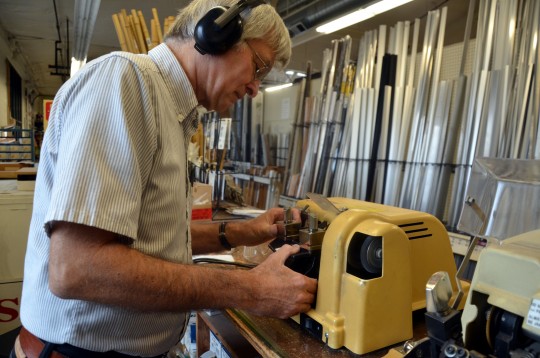
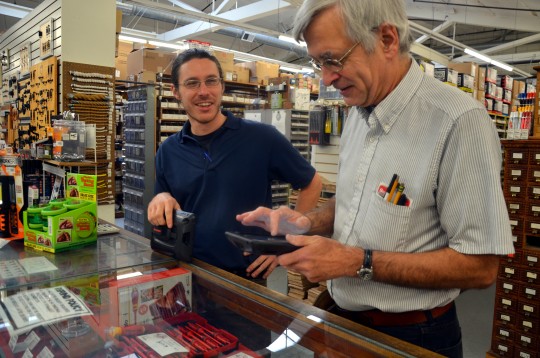
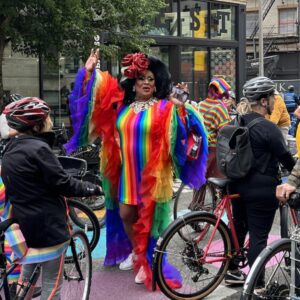
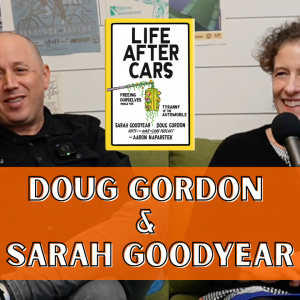
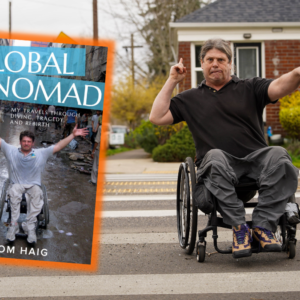
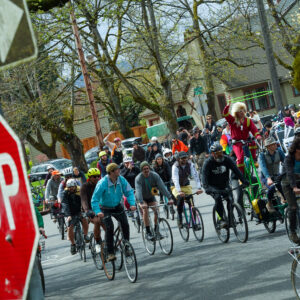
Thanks for reading.
BikePortland has served this community with independent community journalism since 2005. We rely on subscriptions from readers like you to survive. Your financial support is vital in keeping this valuable resource alive and well.
Please subscribe today to strengthen and expand our work.
Learned so much about Doug reading this. Truly inspirational to me.
Thank you Doug! And thank you for your work on this post Michael.
Question I’m left with after reading this and thinking about our current conundrum of housing unaffordability that is pushing out our young artists, dreamers and activists…. Who will be the next Doug Klotz?
I didn’t know who Doug Klotz was until reading this profile. Now I realize that for years I’ve been enjoying the benefits of his hard work.
On the chance that you read these comments, Mr. Klotz, you have my sincere and heartfelt thanks.
Buffers on sidewalks and a requirement that building entrances be at sidewalk level. This is fantastic and important work! Thank you, for your service to our community, Doug.
“It’s very likely true that this was a violation of the RNA’s rules…”
Sorry to belabor this, but I think this could be made more clear. Why is making a statement that someone is “less than bike friendly” a public statement representing the views of the organization?
Check out the investigative committee’s conclusion (also linked above). Their reasoning was a little complicated but I think they summarized things well. https://drive.google.com/open?id=0B9siMKlWupv0aEdnc1ZEWHZIdzhOU3ZOcTFSTFNkbWZDVkFz
The RNA’s rules forbid board members from publicly characterizing the general views of other board members. That’s a little bit weird and there are definitely shades of interpretation here, but for better or worse those were, at least arguably, the rules.
It’s also worth noting that the same committee recommended changing the rules.
Nice write up. I was already a big fan of Winks, now I have even more reason to spend more money that I should there! 🙂
Thank you for writing this!
Three (hundred) cheers for Doug! What a champion.
And a very nice tribute, Michael!
I had to laugh at this, though: “cars are kind of a fact of life” (Michele Wong)
One of those things that you only hear voiced when there’s some threat, eh?
Cars are a fact of life now, but not a sustainable one and one that is hurting citizens who drive them, and who bike or walk. Cars even hurt our planet. Look at the 1/3 missing of our ozone layer and climate change.
Thank you for your quarter century of service, Doug!
Excellent piece, Michael, thank you.
Doug was at some of the first meetings and hearings I attended. During the battle over apartment parking we got to know each other at Planning and Sustainability Commission hearings and he has been a fast friend, confidant, and inspiration.
His impact on the city is multiplicative, in advising and mentoring new activists he’s causing changes that you could barely even track back to him.
I’ve witnessed people who definitely don’t agree with Doug’s ideas lean on him as an institutional resource, and he is willing to give honest advice, it seems, no matter who asks him.
Thanks for writing this, Michael, and thanks again Doug for all you’ve done and continue to do!
“His impact on the city is multiplicative, in advising and mentoring new activists he’s causing changes that you could barely even track back to him.”
Two personal examples tracking back to Doug:
1. Doug was a stranger to us when he tipped us off in 2011 about the plans on the drawing board to practically encircle the historic Paramount Apartments with freeway ramps as part of the I-5 widening plan near the Rose Quarter. I had been advocating for over ten years for traffic engineering changes to N. Broadway/Flint/Wheeler, one of the most dangerous intersections for bicycle/motor vehicle collisions in the city. My subsequent involvement in this freeway-widening/N-NE Quadrant land-use development committee gave a context and forum to galvanize a critical advocacy-mass to demand real change at this location. Some changes have already been made, and stay tuned: ODOT is now in the process of removing their right-turn freeway off-ramp there, and adding a conventional traffic signal!
2. Doug mentioned a few months ago that he thought too many trees were scheduled to be cut down as part of an ODOT safety project on a 14-block stretch of close-in SE Powell. He said the visibility issue is due to lack of tree maintenance (keeping suckers cut, limbing up trees, etc), not the trees themselves. He inspired me to follow up on it, and after some emails and phone calls, the number of trees approved to be cut down now has gone from 26 to only 6!
Great write-up, Michael! I’ve had the pleasure of working with Doug since I moved to Richmond this summer. He’s a great guy and super passionate about the city he lives in. Richmond and the city as a whole are better off with him on the board and involved in various land use committees.
Thanks, Doug!
Here’s to many more years of being an optimistic, unrelenting pain in the ass! Thanks Doug and thanks Michael for the top-notch tribute. Portland’s lucky to have you both.
Doug and I arrived in town at about the same time. I lasted about 12 years doing hardcore advocacy before I got burned out and quit; but Doug’s still at it. I followed the RNA election issues this year fairly closely and am pretty sure that Doug got a bum rap on that, fueled by pettiness on the part of the people that got voted out.
What a great profile! I’ve had the fortune of talking with Doug a number of times in the past months (I recently moved to Richmond), but I never knew the full extent of all of his work through the years. Truly inspiring. Thanks so much Doug!
“I never knew the full extent of all of his work through the years.”
I suspect that is true for many of us.
Even the-wife-who-goes-only-by-her-initials learned something here. Mostly, from the comments, I’m seeing how much appreciation there is for what Doug has achieved. And there’s so much that hasn’t yet borne fruit. Thank you all.
You just outed yourself on here you know! Nice write up!
With complete clarity.
Wow. Local livability hero. Great work, Doug!
Doug’s a nice guy and a good example of an involved citizen having a good time making a difference – thanks Michael, thanks Doug.
Millennials…you could learn a LOT from this guy.
…also everyone else.
Again thankful for the thorough reportage of BikePortland (great article, Michael) and for this thoughtful, practical and diligent (and interesting!) neighbor and activist I knew little about until now. So right that you shone some light on him and his work here. I’m inspired and am excited to hear about this: “Lately he’s become passionate about getting trees to be planted closer to street corners, to reduce the size of heat islands at intersections.” We’re about to plant a bunch of trees and greenery near our busy street and I hope it’ll be contagious.
Excellent photography Michael
Bravo Doug! Keep up your excellent work, but some of you 20, 30 and 40 somethings have got to step up!
Those of us who got into this effort to rebuild Portland as a livable city in the 80’s were building on the foundation of the 70’s laid down by the wonderful Ernie Bonner, the infamous Neil Goldschmidt, et.al. We have been wildly successful beyond our dreams. Hence the housing crisis!
A couple of corrections: Oregon Walks began as the Willamette Pedestrian Coalition, Doug and Ellen V. were co-founders.
Division Street never had a streetcar! Hence the lack of old commercial buildings like those on Hawthorne, Belmont, Clinton, etc.
Lenny: I thought for a long time Division never had a streetcar. Doesn’t show up in “Fares Please” (book) or other sources. Then in the Division Streetscape civil plans, there are the rails in the street, but only from about 33rd to 39th, AFAIK. Turn south at 33rd. Which makes sense, given that’s where the only “streetcar era” buildings are. Don’t know how long it ran there.
Doug
Lenny, I would have to stress the long game. Its easy enough for professional developers and money folk to drag the process out until the opposition fades. This is their job and their tactic. The community organizer often has a 3 year shelf life. Other things invade and usurp that energy and desire..jobs, family, health,etc Organize. of course, but build your institutions, the BTA and CCC and neighborhood associations and civic groups, to sustain the effort for the long haul. The minute you fade is the time the forces of atrophy and opposition swoop in. Congratulations to Mr Klotz, who seems to understand the long game. And thank you, sir!
I loved Doug’s drawings the first time I saw them at the 1998 ProBike ProWalk conference in Santa Barbara…they made urbane planning and street engineering so “simple” to visualize…
…something rare back in the day that the www was so much less of a resource that you had to trip over a hard copy of a resource and request a copy in the mail…no PDF downloading.
And back then as citizen transportation / design advocates, we found that they “xeroxed” really well when we borrowed them in advocating for pedestrians in Honolulu in the 90’s
“Good citizens are the riches of a city.” C.E.S. Woods
https://en.m.wikipedia.org/wiki/Skidmore_Fountain
Doug rocks! Such a visionary and dedicated person who knows pedestrian issues and urban design better than almost anyone in town. I had the honor of working with him on the Portland Pedestrian Advisory Committee.
Doug is a self-taught Sherlock Holmes of urban development history. In the Rose Quarter area, he dug up archival aerial photographs, plat maps, etc., overlaid drawings of future development plans, and then illustrated how to recapture the historic sight lines, street wall, and pedestrian experience of a neighborhood that had been largely destroyed. So well-researched, illustrated, succinct, and humble was his presentation that it was immediately incorporated into both city and state long-term planning.
Looks like he beat them at their own game. Good riddance.
Thanks, Doug!
And if ya’all ever need specialty nuts and bolts, stop by Winks Hardware on SE Stark and 2rd. One of Portland’s finest hardware institutions.
https://www.google.com/maps/@45.5193729,-122.6633448,3a,75y,204h,89.52t/data=!3m7!1e1!3m5!1svlVIczG1NUyqWHRMRQwHTw!2e0!6s%2F%2Fgeo0.ggpht.com%2Fcbk%3Fpanoid%3DvlVIczG1NUyqWHRMRQwHTw%26output%3Dthumbnail%26cb_client%3Dmaps_sv.tactile.gps%26thumb%3D2%26w%3D203%26h%3D100%26yaw%3D287.09222%26pitch%3D0!7i13312!8i6656
One reason Portland has so many beautifully restored old homes is because of hardware stores like Winks, Hippo, The Rebuilding Center, Restoration Hardware. Winks might look modest from the curb, but it has a huge inventory of everything you need to keep your old house alive and smoothly operating.
Portland’s pre-WWI housing stock is in great shape in part because of Winks and employees like Doug. Next time you’re in the older neighborhoods of Tacoma, where the pre WWI housing stock has all been turned into poorly executed Home Depot reno projects, thank your lucky stars you live in a city with Winks, and staff like Doug.
Ted Buehler
Doug Klotz, you’re my hero. And what a great write-up, Michael. Go Team!
Thanks Michael. And thank you Doug. You have contributed tremendously to the livability of this great place and you continue to bring value to our city and specifically Richmond neighborhood.
Several years ago, I attended several City of Portland Pedestrian Advisory Committee meetings, as an observer. I was blown away by Doug’s knowledge of sidewalk construction details; e.g., ramp designs, curb cuts, grades, etc. (My spouse is a Civil Engineer, so I know that construction details really matter.) I was also impressed with Doug’s ability to clearly articulate the trade offs among the different design alternatives.
As someone who walks a lot now, I’m extremely grateful for Doug’s dedication and volunteer service. And thanks to you, Michael, for a nice article.
Great article! Doug Klotz, you’re awesome.
thanks, michael. more stories like this if you can find them.
and doug, it was a pleasure to know you, however briefly, during my time in portland.
Inspirational
I stand corrected on the Division streetcar question. That explains the stretch of commercial streetcar era buildings in the 30s to the 50th on D. Street.
Joe, whether we like it or not, it is a long game…nothing happens quickly in a city so in love with process (good) and with such a weak mayor government (maybe not so good?).
That said, when I returned to my old home town in the mid 80’s it was just beginning to awake from the devastating Regan Recession, and since then its been taking off like never before…well maybe since the 1905 Lewis and Clark Exposition.
I disagree with the interpretation of the investigative committee (SE Uplift) which found Doug violated RNA’s rules*, but otherwise a solid piece about a great guy.
*If a candidate suggests that people who are advocating for something better show up and vote instead of sitting around typing on a Google group at each other, or that neighbors should get involved with their neighborhood association if they want the kind of neighborhood changes they are griping about not happening, that candidate is not “representing the views of the board.” He was encouraging people to get involved by doing more than typing and clicking. Though we live in the next neighborhood association over, I’m very pleased that Doug retained his position in RNA.
Thanks Michael for the excellent article, and Doug for your decades of productive involvement.
Well, let’s look at the actual text of the code of ethics. From http://richmondpdx.org/wp-content/uploads/2010/07/RNA-Code-of-Ethics.pdf, emphases added:
Except in special cases that don’t seem to apply here, there’s nothing undignified, disrespectful, unfair, unequal, or abusive about saying, in public or private, “I don’t like how Board Members A, B, and C deal with topics X, Y, and Z. Let’s recruit candidates and/or ‘get out the vote’ — in other words, use democracy — to replace them with people who deal with those topics in a way I like better.”
There is a world of difference between acting as an unauthorized spokesperson for an organization (which is what the above excerpt prohibits) and sharing what is clearly your personal opinion of specific individuals (which is what Doug did). Restricting the latter is a clampdown on free speech, and I find it disturbing that the Southeast Uplift grievance committee interpreted the code of ethics the way it did.
Doug has been tireless and tenacious in his advocacy. Always fighting to move Portland toward becoming a better place for walking (and biking). Always working toward a long term vision for Portland. Never – it seems to me – for personal gain. He could teach city planners more than a thing or two, and has certainly inspired – and sometimes challenged – me. I don’t know anyone who can simultaneously be so focused on the smallest details of sidewalk design (I remember his battles to preserve the sidewalk builders’ stamps – the ones near corners with the names and year built), while never losing sight of the big picture things that make cities work for people. “Density” is a scary word for many, but it seems different listening to Doug. Density = more people = more pedestrians = more pedestrian-oriented places (if we do it right).
So can anyone explain why he was nearly voted off the board? What were 150 of his neighbors upset about? Is it really about commercial buildings’ parking requirements?
My take:
(a) a technical violation arising from several emailed statements of Doug’s + a set of NA bylaws that were rather specific in the kinds of speech they proscribed;
(b) Doug’s been a dogged and outspoken champion of certain kinds of policies and priorities for a long time (see article above). As such, it can be fairly easy to install a free lightning rod on his roof in an attempt to attract or channel neighbor dissatisfaction with X or Y or Z.
I remember Doug as the outspoken, persistent leader of the Willamette Pedestrian Coalition in the 1990’s.
Micheal, great article…and even better topic. For those of you on here that haven’t yet met Doug, I hope you have the opportunity and then become inspired to follow his example. Doug great to see you again yesterday. Tom
This was a lovely example of why I read this website. Thank you.
Doug Klotz, you rule!
Hi Doug — remember me? I used to go with Oregon Walks in pedestrian actions when it was Willamette Pedestrian Association. You were one of my first friends when I moved to Portland from Salem. It was you who introduced me to Belmont and Hawthorne neighborhoods. I come into Wink’s once and a while to get something specialized, and we always say “Hi.” Thanks for all your great advocacy. It’s shocking to me that your neighborhood members have attacked you so viciously for almost no reason. And I’m amazed at how well you’re weathering this mess. The article about you is inspiring. Thanks to Michael for writing your bio.